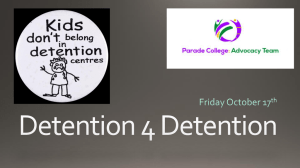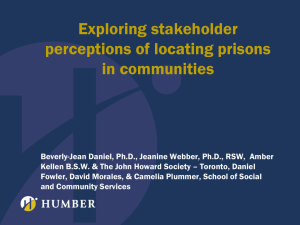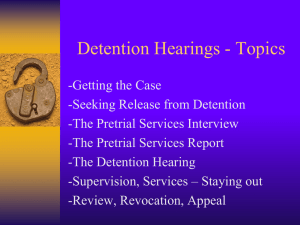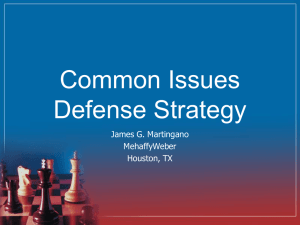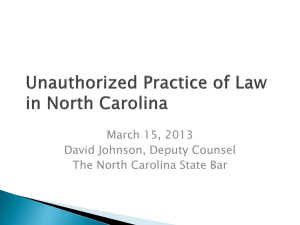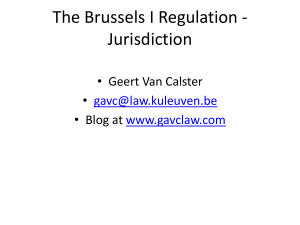Gerald Durcan
advertisement
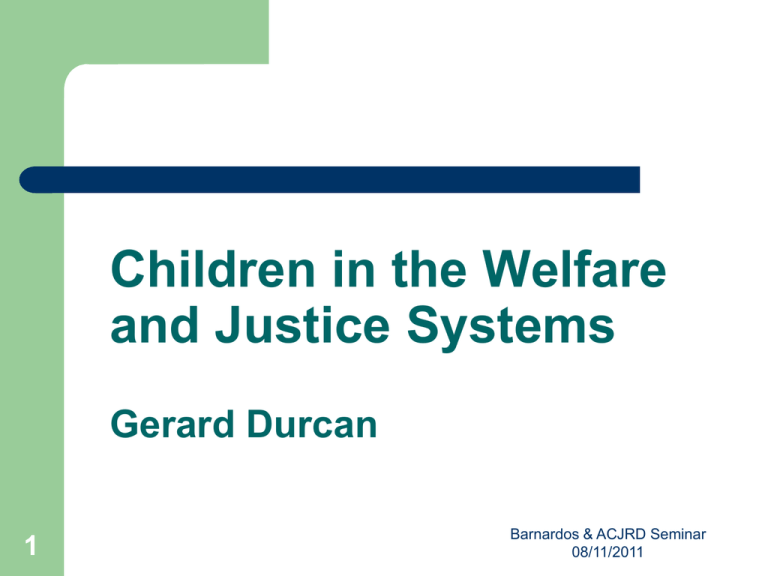
Children in the Welfare and Justice Systems Gerard Durcan 1 Barnardos & ACJRD Seminar 08/11/2011 DETENTION OF CHILDREN PURSUANT TO THE INHERENT JURISDICTION OF THE HIGH COURT INITIAL CASES 2 There was no power of detention of children in the Child Care Act 1991 as originally enacted. In late 1994 a series of cases on behalf of children were commenced. The children had a variety of psychiatric or conduct disorders. It was alleged that the State had failed in its constitutional duty to provide appropriate facilities in which they could be detained for treatment. The origins of the cases were often the District Court where the children were the subject of criminal charges. Barnardos & ACJRD Seminar 08/11/2011 DETENTION OF CHILDREN PURSUANT TO THE INHERENT JURISDICTION OF THE HIGH COURT F.N. v. THE MINISTER FOR EDUCATION AND OTHERS 3 A number of cases came for on for hearing before Mr Justice Geoghegan in February 1995. The position of the State was that there was no constitutional obligation to provide services over and above those then available. However the State acknowledged that the situation was highly undesirable. Barnardos & ACJRD Seminar 08/11/2011 DETENTION OF CHILDREN PURSUANT TO THE INHERENT JURISDICTION OF THE HIGH COURT F.N. v. THE MINISTER FOR EDUCATION AND OTHERS 4 It said that there was short term and longer term plans to remedy the problem. The lead case was F.N. v. The Minister for Education and Others. F.N. suffered from a hyperkinetic conduct disorder. There was expert evidence that he needed a secure unit which could contain him safely while confronting his behaviour. Barnardos & ACJRD Seminar 08/11/2011 DETENTION OF CHILDREN PURSUANT TO THE INHERENT JURISDICTION OF THE HIGH COURT THE DECISION IN F.N. 5 The decision of Mr Justice Geoghegan was given on the 24th March 1995. He held that where a child has very special needs there was a constitutional obligation on the State under Article 42.5 to cater for those needs. The State was under a constitutional obligation to establish suitable arrangements for containment with treatment for F.N. Having regard to the attitude of the State the Judge did not make any immediate declaration or order but simply adjourned the proceedings. Barnardos & ACJRD Seminar 08/11/2011 DETENTION OF CHILDREN PURSUANT TO THE INHERENT JURISDICTION OF THE HIGH COURT D.T. v. THE EASTERN HEALTH BOARD AND OTHERS 6 Another of the cases at hearing before Mr Justice Geoghegan was D.T. v. The Eastern Health Board and Others. D.T. was a twelve year old girl with significant difficulties. During the hearing her situation became acute – there was compelling evidence that she might kill herself. In these circumstances Mr Justice Geoghegan made an order that she be detained in Oberstown House. The Judge made clear that only in extreme circumstances would a Confinement Order be made pursuant to the Constitution. This was the first case where a child’s constitutional rights were protected by the making of an order for his or her detention. Barnardos & ACJRD Seminar 08/11/2011 DETENTION OF CHILDREN PURSUANT TO THE INHERENT JURISDICTION OF THE HIGH COURT FOLLOW ON CASES 7 Further similar orders soon followed. In D.D. v. The Eastern Health Board Costello J made an order authorising the detention of D a twelve year old boy in a unit managed by the Health Board. Over the following two years an increasing number of detention orders were made. Barnardos & ACJRD Seminar 08/11/2011 DETENTION OF CHILDREN PURSUANT TO THE INHERENT JURISDICTION OF THE HIGH COURT D.G. v. THE EASTERN HEALTH BOARD AND OTHERS 8 The first case involving a Detention Order to go to the Supreme Court was D.G. v. The Eastern Health Board and Others. D.G. was seventeen years of age and had significant conduct difficulty. In the absence of anywhere else suitable, Kelly J. ordered his detention in St Patrick’s Institution for a limited period of weeks. This order was challenged on the basis that the power to detain a child under the inherent jurisdiction did not extend to detention in a penal institution. Barnardos & ACJRD Seminar 08/11/2011 DETENTION OF CHILDREN PURSUANT TO THE INHERENT JURISDICTION OF THE HIGH COURT THE DECISION IN D.G. 9 In D.G. there was no challenge to the general concept of a power to detain under the inherent jurisdiction. The challenge was limited to the power to detain in a penal institution. The Supreme Court held that the Order made by Kelly J. was lawful and was necessary to protect the constitutional rights of D.G. However the jurisdiction to detain a child in a penal institution should only be exercised in extreme and rare occasions and for a short period. Barnardos & ACJRD Seminar 08/11/2011 DETENTION OF CHILDREN PURSUANT TO THE INHERENT JURISDICTION OF THE HIGH COURT THE DECISION IN D.G. 10 The European Court of Human Rights subsequently found that the detention of D.G. breached his rights under Article 5 of the Convention. Recently the High Court has ordered the detention of a sixteen year old boy in St Patrick’s Institution for a short period. Again there was no other suitable alternative available. Barnardos & ACJRD Seminar 08/11/2011 DETENTION OF CHILDREN PURSUANT TO THE INHERENT JURISDICTION OF THE HIGH COURT T.D. v. THE MINISTER FOR EDUCATION AND OTHERS 11 Cases on behalf of children tended to seek appropriate facilities in which the child could be treated. In two cases Mr Justice Kelly granted mandatory orders directing the State to make such facilities available. In T.D. v. The Minister for Education and Others the Supreme Court overturned such an Order stating it breached the doctrine of separation of powers. Some Judges in T.D. called into question whether F.N. had been correctly decided. On the other hand in a slightly earlier Supreme Court case North Western Health Board v. H.W. and C.W. a number of the Judges seemed to approve F.N. Barnardos & ACJRD Seminar 08/11/2011 DETENTION OF CHILDREN PURSUANT TO THE INHERENT JURISDICTION OF THE HIGH COURT S.S. v. THE HEALTH SERVICE EXECUTIVE 12 S.S. v. The Health Service Executive and Others contains the most comprehensive review of the use of the inherent jurisdiction to detain children. The decision of Mr Justice MacMenamin establishes a number of principles. Detention Orders should only be granted in exceptional circumstances. They should be short term. They should be for therapeutic purposes. They should be subject to periodic review. Barnardos & ACJRD Seminar 08/11/2011 DETENTION OF CHILDREN PURSUANT TO THE INHERENT JURISDICTION OF THE HIGH COURT PLACING CHILDREN ABROAD 13 In Western Health Board v. K.M. the Supreme Court accepted that the District Court could lawfully authorise placement of a child abroad with members of his extended family. The Court could give a direction to this end pursuant to s.47 of the Child Care Act, 1991. In East Coast Area Health Board v. M. (M). And M. (P). The High Court held that the District Court could direct that a child be placed abroad in residential care. In Health Service Executive v. J.J.B. the High Court used the inherent jurisdiction to authorise the placement of a child in secure care in Boys Town in Nebraska. Barnardos & ACJRD Seminar 08/11/2011 DETENTION OF CHILDREN PURSUANT TO THE INHERENT JURISDICTION OF THE HIGH COURT THE USE OF THE BRUSSELS II A REGULATION 14 In the past year a number of children have been placed in secure care in institutions in Scotland. The only legal basis for their detention has been the Irish High Court Order. The Brussels II A Regulation provides that the Member State where the child is habitually resident has jurisdiction to make orders in respect of parental responsibility. Such orders are entitled to recognition and enforcement in other Member States. The Regulation covers Public Law Orders and Article 56 sets out certain requirements in regard to placement of a child in an institution in another Member State. Barnardos & ACJRD Seminar 08/11/2011 DETENTION OF CHILDREN PURSUANT TO THE INHERENT JURISDICTION OF THE HIGH COURT RECENT DEVELOPMENTS 15 Issues have now arisen about the placement of Irish children in psychiatric units in England. Can such a placement occur pursuant to the Brussels II A Regulation? If it can what are the functions of the Courts in each State? These issues will be addressed within the next few weeks in the High Court. Barnardos & ACJRD Seminar 08/11/2011 DETENTION OF CHILDREN PURSUANT TO THE INHERENT JURISDICTION OF THE HIGH COURT THE LEGISLATIVE BACKGROUND 16 A power to make Secure Care Orders in regard to children was inserted in the 1991 Act by the Children’s Act 2001. That power was brought into operation. However no units were ever approved by the Minister. The Child Care (Amendment) Act 2011 amends the 1991 Act to give statutory power to the High Court to make Special Care Orders. However those provisions are not yet in effect. Barnardos & ACJRD Seminar 08/11/2011 DETENTION OF CHILDREN PURSUANT TO THE INHERENT JURISDICTION OF THE HIGH COURT OVERVIEW 17 In 1995 a lacuna in the Child Care Act 1991 was identified. There was no power to detain children for treatment even if that was necessary to protect their welfare. Sixteen years later that difficulty has still not been satisfactorily resolved. During that period the inherent jurisdiction has been used to fill the gap. No statutory or regulatory framework has applied. Even when the provisions contained in the 2011 Act come into operation. The inherent jurisdiction may still have to be invoked. Barnardos & ACJRD Seminar 08/11/2011
